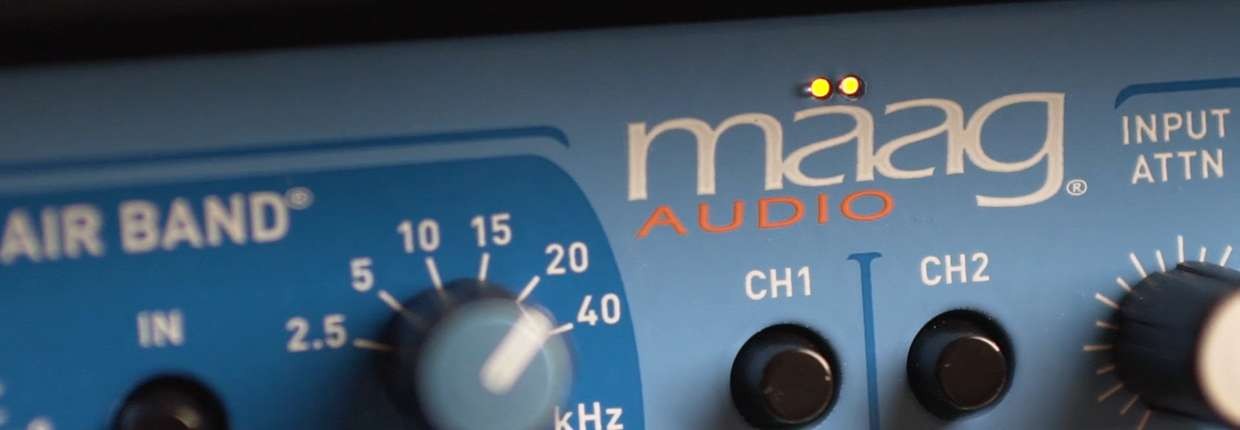Recording, Mixing and Mastering
Published on 21/08/2023

Mäag Audio was founded by Cliff Maag Sr, an audio engineer with over 35 years of experience in the professional audio world.
Cliff's strong passion for high quality sound is the catalyst for all Mäag audio devices.
Cliff's innovations include the NTI EQ3 and Nightpro Preq3/EQ3D. It is in these projects that Cliff introduced the famous Air Band® to the world (in the early 90s).
Since then, the Air Band® has been a distinctive prestige feature for the entire Mäag catalog.
Cliff, in addition to making pro audio gear, also works out of his own production recording studio, the Record Lab treating established high-end clients and local bands seeking space in the show biz alike.
The Mäag audio team strives for excellence. Their goal is to provide all sound engineers with cutting-edge technology that we all need.
Shelving filters have a response curve that attenuates or boosts signals below a given frequency (low shelf) or above it (high shelf). The frequency that discriminates the behavior of the device is called the cutoff frequency.
The level of selectivity or, if you will, the ability to discriminate between frequencies, depends on the slope of the curve near the Cutoff Frequency. This is measured with the slope of the curve. The lower is the curve the larger is the impact on the overall audio spectrum of the filter.
Something else occurs near the cut-off frequency. Here we have a phase rotation (which has an impact on the coherence of the sound message) which is greater the greater the slope of the gain curve.
The Air Band® section is one of a kind. It works in boost mode on high frequencies (positive gains only) and implements a curve with a fairly low slope (more or less 2dB/oct).
The low slope results in minimized phase shift for the benefit of the phase coherence of the processed signal.
Another effect is that the gain variations are also found quite far from the cutoff frequency.
The section has its own bypass button and gain control which can be set up to a maximum of +17dB. The effect, however, covers a significant part of the audio band.
In fact, the Air Band® also seems to introduce a general increase in the level over the entire audio band. This is especially noticeable at higher gain settings.
For this reason, in some cases, the designers have decided to include the Input Gain among the available controls (as, for example, in the EQ2).
The cutoff frequency of the Air Band® is adjustable between 2.5, 5, 10, 15, 20 and 40 kHz.
The 15kHz band has recently been introduced on devices such as, for example, the EQ4M which inherited it from the design of the Mäag Audio EQ2.
This band obviously offers a useful compromise between the original 10 and 20 kHz options.
Here are some of the possible uses of the Air Band® section:
Air Band® can be usefully employed by referring to the Pultec approach.
This technique consists in using the same frequency with two different filters in the same device.
Due to the different bandwidths and phase response of the filters, the result is not obvious (it is not just the sum of the two gain levels) and can, in particular cases, be very interesting.
L’EQ4M is a two-channel equalizer dedicated to mastering.

Among its features we find:
Although the EQ4M was designed with mastering in mind, it can be useful for mixing (both bus and individual channels) and - why not - tracking
Although the available bands work at fixed frequencies, the design seems to have been made so that each filter was dedicated to a specific objective.
The curves feel broad enough to ensure solid, musical control over each band.
The sound is coherent across the entire audio spectrum and this is probably due to intelligent phase management of each filter cell and the entire device.
The combined use of the 10Hz and 40Hz bands delivers solid, powerful bass.
The 160Hz and 650Hz bands are very useful and effective in the midrange. Even a small knob variation can be clearly heard, and it's very difficult to find a setting that sounds bad.
We have already talked about the high range treatments that can be applied with this device.
We just want to explicitly add that the Air Band® is extremely effective.
The overall sound is clean and solid, respectful of the source but very effective in the applied variations. It does not act surgically, therefore it is not suitable for compensating mixing errors.
For all the rest it is more than effective and gives a very good idea of what one should expect from a good mastering.
ou can get an idea of what has just been said by watching our video:
PREQ2 is a double microphone preamplifier with EQ and Air Band®. In the input circuit, the microphone transformer feeds a differential set of discrete Class A front-end transistors coupled to a FET input op amp. This guarantees a detailed and, at the same time, full-bodied sound.

It has the following features:
EQ2 is a 500 series device. It is an uncompromising two-band equalizer with Air Band®.

Good for tracking can be used successfully in the mix as well. Here are some features:
EQ4 is a 1-channel six-band equalizer, with Air Band® (shelf boost from 2.5 to 40 kHz).

The Maag EQ4 is in API 500 format and guarantees sonic transparency and presence of high frequencies, while maintaining the natural sound.
EQ adjustments are achieved with minimal phase shift thanks to a proprietary design.
As you can now understand, the Air Band® is so popular (and useful) that it is used on almost all Mäag Audio products. When tested, it is always effective and useful for taking the sound one step further. Try it for yourself by coming to visit us in the showroom Milk Audio Store.
Join us today and get 5% off your next order!

Empty cart